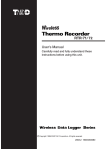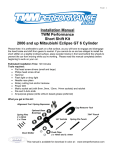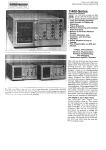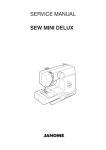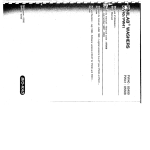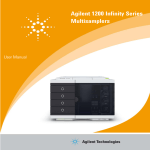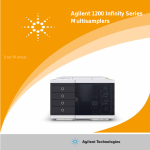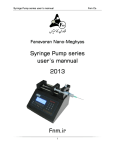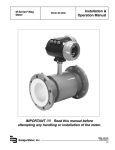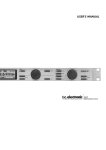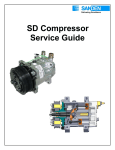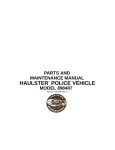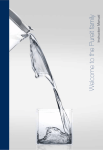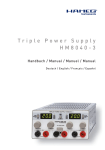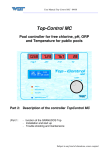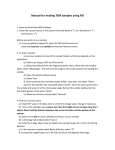Download Microplate Washer LP40/LP41 User manual
Transcript
Microplate Washer LP40/LP41 User manual User Manual code : 40B030e Revision September 2005 English 3 rue Denis Papin – 67300 Schiltigheim – France – tel. (33) 3 88 19 70 50 – fax (33) 3 88 62 52 98 TABLE OF CONTENTS ABOUT THIS MANUAL 4 IMPORTANT NOTICE 4 SAFETY INFORMATION 5 SAFETY SYMBOLS 6 1•FEATURES AND SPECIFICATIONS 7 1.1 1.2 1.3 1.4 1.5 1.6 1.7 1.7.1 1.7.2 1.7.3 1.7.4 1.8 1.8.1 1.8.2 1.8.3 LP40 BASIC FEATURES LP40 OUTSIDE DIMENSIONS [mm] LP40 HYDRAULIC CIRCUIT LP41 BASIC FEATURES LP41 OUTSIDE DIMENSIONS [mm] LP41 HYDRAULIC CIRCUIT TECHNICAL FEATURES ELECTRICAL DATA PHYSICAL DATA HARDWARE SPECIFICATIONS SOFTWARE SPECIFICATIONS SOFTWARE PARAMETERS FOR WASH PROTOCOLS WASH PROTOCOL DEFINITION METHODS PARAMETER’S DEFINITIONS 7 8 9 10 11 12 13 13 13 13 14 15 15 16 18 2• INSTALLATION 27 2.1 27 UNPACKING 3• OPERATING INSTRUCTIONS 3.1 3.1.1 3.2 3.3 3.4 3.4.1 3.4.2 3.5 3.5.1 3.5.3 3.5.4 3.6 3.6.1 3.6.2 3.7 RUN MODE HOW TO USE THE KEYBOARD MICROPLATE LOADING SELECT ONE KIT WASH INTERRUPTION OR POWER FAILURE WASH INTERRUPTION POWER FAILURE RINSE RINSE (W ITH LP40) RINSE (W ITH LP41) AUTOMATIC RINSING (W HIT LP41) CONFIGURATION MAIN MENU WASHER'S CONFIGURATION PROGRAMMING 29 29 29 30 31 33 33 33 34 34 35 35 36 36 37 40 3.7.1 3.7.2 3.7.3 3.7.4 3.7.4.1 3.7.4.2 3.7.4.3 3.7.4.4 3.7.4.5 3.7.4.6 3.7.5 3.7.5.1 3.7.5.2 3.7.5.3 3.7.5.4 3.7.6 3.7.6.1 3.7.6.2 3.7.6.3 3.7.6.4 3.7.7 3.7.7.1 3.7.7.2 3.7.8 3.7.8.1 3.7.8.2 3.7.8.3 3.7.8.4 3.7.9 3.7.10 KIT STRUCTURE ACCESS TO PROGRAMMING MODE PROGRAMMING SYNOPSIS ADD ADD: KIT ERRORS in KIT programming ADD: METHOD ERRORS on METHOD programming ADD: PLATE ERRORS on PLATE programming INSERT INSERT:KIT TEMPORARY KIT INSERT : METHOD INSERT: PLATE DELETE DELETE:KIT DELETE: METHOD DELETE: PLATE ERROR in PLATE deletion EDIT EDIT: KIT EDIT: PLATE COPY COPY: KIT ERRORS in KIT copy COPY : PLATE ERRORS in PLATE copy PLATE TEST RAM INITIALIZATION 4• MAINTENANCE & TROUBLESHOOTING 4.1 4.1.1 4.1.2 4.2 4.2.1 4.2.2 4.3 4.3.1 62 ROUTINE MAINTENANCE PROCEDURES DAILY MAINTENANCE WASHER STORAGE CONDITIONS CLEANING AND DISINFECTION CLEANING THE MANIFOLD DISINFECTION TROUBLESHOOTING HARDWARE AND SOFTWARE VERSION RECOMMENDATIONS FOR OPTIMIZED CONDITIONS ON LP40 / LP41 WASHERS 40 41 42 43 43 44 45 46 47 50 51 51 51 51 52 53 53 53 54 54 55 55 57 58 58 58 59 59 60 61 62 62 62 63 63 64 65 65 WASHING 66 APPENDIX 67 REVISION UPGRADE DESCRIPTION 67 INDEX 68 2 IMPORTANT Please read carefully before using the PLATE WASHERS LP40 or LP41 This document is the copyright of Bio-Rad and must not be copied or reproduced in any form without prior consent. Bio-Rad reserves the right to make technical improvements to this equipment and documentation without prior notice as part of a continuous program or product development. This manual supersedes all previous editions. NOTA : The LP40/41 microplate washers can be integrated into a system together with other instruments, in order to make biologic medical assays. 3 About this manual This manual has been written for the laboratory technician and describes how to use the LP40 and LP41 plate washers. This manual is designed to give you the necessary information you need to : • install the LP40 or the LP41 • operate with the LP40 or the LP41 to suit your particular needs • perform the LP40 or the LP41 basic maintenance procedures, including disinfection. This manual also describes all the features and specifications of the LP40 and LP41 hardware and configuration software. Important Notice Before installing this unit, please read carefully the installation instructions. This instrument can only be used to wash 96-well microplates with 8, 12 or 2*8 channel manifolds or 384 well micro-plates with 1*16 channel manifold. This washer is intended for clinical diagnostic and research laboratory use and must be operated only by specialized personnel aware of the potential risks connected to the chemical and bacteriological agents normally used with this unit. The Aerosol Protection Cover must always be closed when the instrument is operated to reduce the risk of contamination from ambient air. Since the unit is not completely sealed, this risk is not completely eliminated, and the operator should dress with appropriate safety protection when using hazardous substances or biological agents. While the unit is connected to the power, it is dangerous to operate without the protective cover. Operation without the cover may be performed only by specialized and trained service personnel. Read carefully the recommendations for optimized washing conditions provided in the appendix of this manual. Contact your local representative if service is required. 4 SAFETY INFORMATION WARNING: ELECTRIC’S SHOCK HAZARD To operate, the instrument must be mandatory connected to a wall socket equipped with earth. The access to the mains supply input plug, located on the instrument’s rear panel, must be kept free in order to use this plug, if necessary, as cut-off device. Although this instrument is fully insulated and grounded, it is important for all users to be aware of the potential hazards of using liquids in close proximity to an electrical supply. In the event of any spillage, the instrument must be immediately isolated from the electrical supply and drained. Spilt liquid should be removed as soon as possible. Serious damage to the instrument may occur if fluid is allowed to penetrate the case. The electrical supply MUST NOT be reconnected until the instrument has been fully inspected by a qualified technician or service engineer. SERVICING MUST ONLY BE CARRIED OUT QUALIFIED TECHNICIAN OR SERVICE ENGINEER. WARNING: SPILLAGES BY A In some operating modes (e.g. dispensing fluids or purging the system, particularly under automatic control) it is possible to overfill the wells of a microplate. This can result in spillage of liquids and/or contamination with hazardous substances. Care should be taken to ensure that overfilling does not occur. If environmentally hazardous fluid is spilled, the instrument must first be isolated from the electrical supply and physically isolated from the working environment by placing it in a fume cupboard or similar location. Contact the nearest service centre for assistance, advising them of the health hazards associated with the spilled materials. WARNING: INCORRECT OPERATION OPERATING THIS EQUIPMENT IN WAYS OTHER THAN DETAILED IN THIS MANUAL MAY IMPAIR THE PROTECTION PROVIDED BY THE INSTRUMENT. DO NOT operate this equipment with the covers removed – potentially dangerous voltages are contained within. DO NOT operate this equipment with the safety earth (ground) disconnected. 5 CAUTION DO NOT poke fingers, pencils or other implements into plate carrier entry slot. BE PREPARED for unexpected movement of the plate carrier and noise from the Washer pump when the Washer is controlled by external computer. ENSURE that the main power cable is correctly wired. Colour codes are as follows : Europe BROWN BLUE GREEN/YELLOW LIVE NEUTRAL EARTH (Ground) United States BLACK LIVE WHITE NEUTRAL GREEN GROUND ENSURE that all connections are tight and all blocking elements (foams, …) have been removed before switching on the Washer. If there is any doubt or concern about the safety of the instrument contact the nearest approved service center. SAFETY SYMBOLS The following alarm and information symbols can be found in several places in the washer. Only a qualified personal aware of the security procedures is allowed to repair this instrument. Please read this manual carefully before using this instrument. Direct current Alternating current Direct and alternating current Earth (ground) terminal Protective earth (ground) terminal ú On Off ! Caution (see enclosed documents) 6 1• FEATURES AND SPECIFICATIONS 1.1 LP40 Basic features Aerosol Protection Cover 2x20 characters LCD Display and 5 "soft" Keys Manifold 8-Channel or 12-Channel • Removable 8-Mode/12-Mode Plate Carrier • Removable • Autoclavable at 120°C/250°F Fig. 1 7 1.2 LP40 Outside dimensions [mm] 280 325 174 193 277,5 277,5 123 125 525,5 Fig. 2 8 1.3 LP40 Hydraulic circuit 8- channel or 12- channel Manifold Electro-valve WASH or RINSE Solution Input Liquid Pump Blue Vaccum Pump Red Yellow Air Output Hydrophobic Filter WASH RINSE WASTE bottle Fig : 3 9 1.4 LP41 Basic features Aerosol Protection Cover RS232 serial port for connection to PC 2x20 characters LCD Display and 5 "soft" Keys 4 liquid inputs Manifold 82*83*8-Channel or 122*12-Channel • Removable 8-Mode/12-Mode Plate Carrier • Removable • Autoclavable at 120°C/250°F Fig. 4 10 1.5 LP41 Outside dimensions [mm] 325 280 174 193 277,5 277,5 123 125 525,5 Fig. 5 11 1.6 LP41 Hydraulic circuit Liquid Level Detection in Bottle * Vacuum Sensing * R G E U 2 Vaccum Pumps Liquid Pump G R N L 2 W 1 O L WASH or RINSE Solution Inputs Air Output Blue E E Y Rinse * 4 E Input #3* Input #2* Input #1 3 Y A Electro-valve L B 2*8 - Channel Manifold Gray Yellow Red Green Hydrophobic Filter Fig : 6 Wash 1 Wash 2 Wash 3 RINSE WASTE bottle * : Depending on options 12 1.7 Technical features 1.7.1 Electrical Data Voltage Consumption Fuses Power Cord 240 / 100 VAC, 50 / 60 Hz 100 VA max 2,5 AT (2 fuses, 5x20 mm) on CEI socket 1.7.2 Physical data Dimensions, including bottles W idth 368 mm,LP40 683mm, LP41 Length 530 mm, Plate carrier out, LP40 & LP41. Height 483 mm, LP40 443 mm, LP41. Weight (without accessories) 11,0 Kg, LP40 11,6 Kg, LP41 Operating conditions 15 - 30 °C / 15 - 85 %R.H. 1.7.3 Hardware specifications Manifold LP40: LP41: Vacuum power LP40 : LP41 : Volume of WASTE bottle LP40 : LP41: User interface : 8 or 12 channel 8, 2*8, 3*8, 12 or 2*12 channel 1 integrated vacuum pump (maxi 8 L/min) 2 integrated vacuum pumps (maxi 16 L/min). 2 litres 8 litres Flat keyboard with 5 diaphragm keys 2x20 characters LCD screen , backlighted on LP41. 13 1.7 Technical features (continued) 1.7.4 Software specifications Kits Up to 75 washing kits programmable. Each kit is saved under its own name (up to 15 characters) and is a combination of methods repeated or not, with or without soaking times, in strip mode or in plate mode. Method 6 single-cycle washing methods : Wash, Aspiration, Dispensing, Bottom Washing, Bottom Aspiration, Agitation. 4 two-cycle washing methods : Wash + Aspiration, Wash + Bottom Aspiration, Bottom Wash + Aspiration, Bottom Wash + Bottom Aspiration. Soak time 0 to 9,9 sec Strip mode 0 to 59 min 59 sec in Plate mode. Repetition Every method can be repeated from 1 up to 9 times. Wash mode Strip mode or Plate mode. Omit strip Strips can be omitted at kit programmation. Plates Up to 10 plate parameter sets programmable. Accepts flat or curved bottom microplates. Vertical and horizontal speeds, vertical and horizontal positions of the aspirating needle in relation with the wells are programmable. Other features -Priming sequence of the hydraulic system at change of Wash solution. -Disinfection program of the hydraulic circuit. -User programming can be inhibited. 14 1.8 Software parameters for Wash protocols This section describes the Wash protocols, their methods and their software parameters. It is useful to be read prior starting to programme new wash protocols or new kits. 1.8.1 WASH protocol definition: A WASH protocol, also called a KIT, is made of a succession of wash Methods. There are 10 different wash methods available and every method is programmed with its own batch of specific parameters. Also, the Wash protocol is associated to a batch of plate parameters -Positions- that are set in respect to plate geometry (flat, U or V shaped well, …) as well as Speeds needed for the wash process. Plate 10 Positions and speeds Wash protocol 75 or Kit 75 Plate 1 Positions and speeds Qqqqqqqqqq d 1 Wash protocol 3 Wash protocol 2 Wash protocol 1 Or Kit 1 Wash or Method 1 Kit 100 NW Wash p or Method 2 Kit 100 NAG Method 3 NA Fig. 7 The available methods are: Method Method name Single-cycle method nW nA nD nw na nA g Wash Aspiration Dispensing Bottom Washing Bottom aspiration Plate Agitation Two-cycle method nW + A nW + a nw + A nw + a Wash + Aspiration Wash + Bottom Aspiration Bottom Wash + Aspiration Bottom Washing + Bottom Aspiration 15 1.8 Software parameters for Wash protocols (continued) 1.8.2 Methods A method is a completely defined module made of one or two elementary cycles. Every kit is made of a succession of methods. In a method, elementary cycles can be repeated n times (n =1 to 9). For a method using two elementary cycles, only the first cycle is applied “n” times. When repeated several times, the waiting time between elementary cycles is called soaking time. The waiting time between two methods is called Method Interval. Whatever the selected mode, STRIP or PLATE (see definition below), a method is always completely finished on the whole plate prior to starting the next method. Available methods: Method Abbreviated name on LCD display Single-cycle method nW WASH nA ASPIRATION nD DISPENSING nw BOTTOM WASH. na BOTTOM ASP. nAg AGITATION Two-cycle method nW + A WASH + ASP nW + a WASH+BOT.ASP nw + A BOT.WASH+ASP nw + a B.WASH+B.ASP Method name Wash Aspiration Dispensing Bottom Washing Bottom aspiration Plate Agitation Wash + Aspiration Wash + Bottom Aspiration Bottom Wash + Aspiration Bottom Washing + Bottom Aspiration Kit parameters associated to method: • MODE STRIP or PLATE STRIP mode: the total method is applied on the strip prior processing the next strip. Example: STRIP mode 3W + A on 1st strip Method 3W + A on 2nd strip 3W +A etc… 3W + A on last strip PLATE mode: the elementary cycle is executed successively on all strips prior applying the next elementary cycle. PLATE mode W on the whole plate W on the whole plate W on the whole plate A on the whole plate 16 1.8 Software parameters for Wash protocols (continued) 1.8.2 Methods (contunued) No. OF CYCLES Number of Cycles = n 1 to 9, step 1 number of elementary cycles that will be applied within the method. • SOAKING Soak time 0min 0s to 59min 0s, step 1s in PLATE mode. 0min 0s to 9.9s, step 0.1 s in STRIP mode. Waiting time between two consecutive elementary cycle within one method. • MET. INTER Method Interval 0min 0s to 59min 0s, step 1 sec Waiting time between two consecutive methods. 17 1.8 Software parameters for Wash protocols (continued) 1.8.3 Parameter’s definitions Parameters directly depending on the KIT or Wash protocol (such as dispensing, aspirating times, liquids, etc…) are called “KIT Parameters”, Parameters depending on the microplate dimensions (mainly POSITION and SPEED parameters) are called “PLATE parameters”. In the washer, the elementary cycles are as follows : A ASPIRATION The aspirating needle goes down and aspirates until reaching the well bottom. The needle is shifted close to wall (Aspiration Horizontal Position) for flat bottom well; it remains centered for a curved bottom well. Programmed parameters: Kit parameters: • CROSW. ASP. Crosswise aspiration “CWA” (for flat bottom only) YES or NO the aspiration needle is shifted close to the wall (Aspiration Horizontal Position) while going down to well bottom and aspirates; once the aspiration time has elapsed, the aspiration needle is going up to approx middle of well height and is shifted opposite end of wall (no scratch on the bottom); the needle goes down to bottom and a second aspiration sequence takes place. • ASP. TIME Aspiration Time 0.1 to 9.9 s, step 0.1 s Time during which the aspirating needle is kept at the well bottom and aspirates. Plate parameters: • ASP. HOR. POS. Aspiration Horizontal Position (for flat bottom only) 0.0 (centered) to 2.0 mm, step 0.1 mm (see also fig. 8 at the end of § 1.8) • ASP.VERT.POS. Aspiration Vertical Position 0.1 to 15.0 mm, step 0.1 mm (see also fig. 8 at the end of § 1.8) 0.1 is the highest needle position 15.0 is the lowest needle position • ASP. DOWNW. SPEED Aspiration Downward Speed 0 to 9, step 1. (speed min. = 0; speed max. = 9) 18 1.8 Software parameters for Wash protocols (continued) 1.8.3 Parameter’s definitions (continued) D.DISPENSING The dispensing needle is placed over the well and dispenses a wash solution in the well. When the dispensed volume is higher than well capacity, the aspiration needle aspirates the overflow to prevent liquid spilling on next wells. Programmed parameters: Kit parameters: • VOLUME (for one well) 50 to 3000 µl, step 50 µl (the well volume is approx. 370 µl) • OVERFLOW 1.0 to 12.9 mm, step 0.1 mm (see also fig.8 at the end of § 1.8). This parameter sets the height of the aspirating needle and thus the height of the liquid in the well. 1.0 is the highest needle position 12.9 is the lowest needle position (for the overflow). It is recommended to dispense a volume slightly higher than wished and have an overflow phase in order to obtain an equal dispensing of volume in each well. The slight flow rate variations among dispensing needles are compensated by the overflow phase. • LIQUID Wash W1 to Wash W9 When launching a kit in the RUN mode, the display will remind you to connect correct Wash bottle prior starting. • FLOW Flow rate compensation -5 to +5, step 1. The flow rate of the dispensing pump is adapted to the operating manifold. However, the flow rate can be slightly modified with this parameter (lower flow rate whith negative value, higher flow rate with positive value). Plate parameters: • DISP. UPW. SPEED Dispensing Upward Speed 0 to 9, step 1. (speed min. = 0; speed max. = 9) 19 1.8 Software parameters for Wash protocols (continued) 1.8.3 Parameter’s definitions (continued) W WASH Aspiration sequence followed by a Dispensing sequence. Programmed parameters: Kit parameters: • CROSW. ASP. Crosswise aspiration “for flat bottom only” YES or NO (See details on page 18) • ASP. TIME Aspiration time 0.1 to 9.9 s, step 0.1 s (See details on page 18) • VOLUME “for one well” 50 to 3000 µl, step 50 µl (the well volume is approx. 370 µl) • OVERFLOW 1.0 to 12.9 mm, step 0.1 mm 1.0 is the highest needle position 12.9 is the lowest needle position “for the overflow” (See details on page 19) • LIQUID Wash W1 to Wash W9 (See details on page 19) • FLOW flow rate compensation -5 to +5, step 1. (See details on page 19) Plate parameters • ASP. HOR. POS. Aspiration Horizontal Position “for flat bottom only” 0.0 to 2.0 mm, step 0.1 mm (see also Fig. 8, at the end of §1.8) • ASP.VERT.POS. Aspiration Vertical Position 0.1 to 15.0 mm, step 0.1 mm (see also fig.8, at the end of § 1.8) 0.1 is the highest needle position 15.0 is the lowest needle position • ASP. DOWNW. SPEED Aspiration Downward Speed 0 to 9, step 1. (speed min. = 0; speed max. = 9) • DISP. UPW. SPEED Dispensing Upward Speed 0 to 9, step 1. (speed min. = 0; speed max. = 9) 20 1.8 Software parameters for Wash protocols (continued) 1.8.3 Parameter's definitions (continued) w BOTTOM WASH . Bottom Washing The bottom of the well is thoroughly washed, followed by a normal Wash (W) sequence. Following sequences are applied : - Downward aspirating movement of the needle into the well down to Aspiration Vertical Position. Aspiration at Aspiration Vertical Position during Aspiration Time. - One or two upward dispensing movements up to Bottom Wash Vertical Position, dispensing at this position during a Bottom Wash Time … - Followed by a downward aspirating movement down to Aspiration Vertical Position. - Aspiration at Aspiration Vertical Position during Aspiration Time. - Dispensing up to Overflow Position. In case of a crosswise aspiration (for flat bottom only): each aspiration sequence (close to the wall) is immediately followed by another aspiration sequence to the opposite end of the wall as described on page 18. Programmed parameters: Kit parameters: • CROSW. ASP. Crosswise aspiration “for flat bottom only “ YES or NO (See details on page 18) • ASP. TIME Aspiration time 0.1 to 9.9 s, step 0.1 s (See details on page 18) • VOLUME “for one well” 50 to 3000 µl, step 50 µl (the well volume is approx. 370 µL) Volume is applied at the last Dispensing sequence. • OVERFLOW 1.0 to 12.9 mm, step 0.1 mm 1.0 is the highest needle position 12.9 is the lowest needle position (for the overflow). Overflow is applied at the last Dispensing sequence. (See details on page 19) • LIQUID Wash W1 to Wash W9 (See details on page 19) • FLOW flow rate compensation -5 to +5, step 1. (See details on page 19) 21 1.8 Software parameters for Wash protocols (continued) 1.8.3 Parameter's definitions (continued) W Bottom Washing (continued) • BOT. WASH NUMBER Bottom Wash Number 1 or 2 Number of Bottom Wash Occurence. • BOTTOM TIME Bottom Wash Time 0.1 to 9.9 s, step 0.1 s Time when dispensing at the Bottom Wash Vertical Position. Plate parameters: • ASP. HOR. POS. Aspiration Horizontal Position “for flat bottom only” 0 to 2.0 mm, step 0.1 mm (see also fig. 8 at the end of § 1.8) Aspiration Horizontal Position is applied for all Aspiration, Bottom Wash and Bottom Aspiration sequences. • ASP.VERT.POS. Aspiration Vertical Position 0.1 to 15.0 mm, step 0.1 mm (see also fig. 8 at the end of § 1.8) 0.1 is the highest needle position 15.0 is the lowest needle position Aspiration Vertical Position is applied for all Aspiration sequences. • B.W.VERT.POS. Bottom Wash Vertical Position 0.1 to 15.0mm, step 0.1mm (see also fig. 8 at the end of § 1.8) 0.1 is the highest needle position 15.0 is the lowest needle position Bottom Wash Vertical Position is the height of the aspirating needle during the dispensing sequence of the bottom wash. • ASP. DOWNW. SPEED Aspiration Downward Speed 0 to 9, step 1. (speed min. = 0; speed max. = 9) This speed is applied only at the first Aspiration sequence. • DISP. UPW. SPEED Dispensing Upward Speed 0 to 9, step 1. (speed min. = 0; speed max. = 9) Dispensing Upward Speed is applied at the last Dispensing sequence. • BOT. DOWNW. SPEED Bottom Downward Speed 0 to 9, step 1. (speed min. = 0; speed max. = 9) Speed of all downward movements for all bottom sequences (wash and aspiration). • BOT. UPWARD SPEED Bottom Upward Speed 0 to 9, step 1. (speed min. = 0; speed max. = 9) Speed of all upward movements for all bottom sequences (wash and aspiration). 22 1.8 Software parameters for Wash protocols (continued) 1.8.3 Parameter's definitions (continued) a Bottom aspiration BOTTOM ASP. The following sequence are applied: - Downward aspirating movement of the needle into the well down to Aspiration Vertical Position. - Aspiration at Aspiration Vertical Position during Aspiration Time. - One or two upward aspirating movements up to Bottom (Aspiration) Position followed by a downward aspirating movement down to Aspiration Vertical Position. - Aspiration at Aspiration Vertical Position during Aspiration Time. In the case of crosswise aspiration (for flat bottom only): every aspiration sequence (close to the wall) is immediately followed by another aspiration sequence to the opposite end of the wall as described on page 18. Programmed parameters: Kit parameters: • CROSW. ASP. Crosswise aspiration “for flat bottom only" YES or NO (See details on page 18) • ASP. TIME Aspiration time 0.1 to 9.9 s, step 0.1 s (See details on page 18) • BOT. ASP. NUMBER Bottom Aspiration Number 1 or 2 Number of Bottom Aspiration Occurence Plate parameters: • ASP. HOR. POS. Aspiration Horizontal Position “For flat bottom only” 0.0 to 2.0 mm, step 0.1 mm (see also fig. 8 at the end of § 1.8) Aspiration Horizontal Position is applied for all Aspiration, Bottom Wash and Bottom Aspiration sequences. • ASP.VERT.POS. Aspiration Vertical Position 0.1 to 15.0 mm, step 0.1 mm (see also fig. 8 at the end of § 1.8) 0.1 is the highest needle position 15.0 is the lowest needle position Aspiration Vertical Position is applied for all Aspiration sequences. 23 1.8 Software parameters for Wash protocols (continued) 1.8.3 Parameter's definitions (continued) a Bottom aspiration (continued) BOTTOM ASP. (continued) Plate parameters (continued) : • BOT.VERT.POS. Bottom (Aspiration) Vertical Position 0.1 to 15.0 mm, step 0.1 mm (see also fig. 8 at the end of § 1.8) 0.1 is the highest needle position 15.0 is the lowest needle position. Bottom (Aspiration) Vertical Position is the height of the aspirating needle during the aspiration sequence of the bottom aspiration. • ASP. DOWNW. SPEED. Aspiration Downward Speed 0 to 9, step 1. (speed min. = 0; speed max. = 9) Aspiration Downward Speed is applied at the first Aspiration sequence. • BOT. DOWNW. SPEED. Bottom Downward Speed 0 to 9, step 1. (speed min. = 0; speed max. = 9) Speed of all downward movements for all bottom sequences (wash and aspiration). • BOT. UPWARD SPEED. Bottom Upward Speed 0 to 9, step 1. (speed min. = 0; speed max; = 9) Speed of all upward movements for all bottom sequences (wash and aspiration). 24 1.8 Software parameters for Wash protocols (continued) 1.8.3 Parameter's definitions (continued) Ag Plate Agitation AGITATION The microplate is shaken horizontally during the Agitation Time with an Agitation Amplitude and an Agitation Speed. Programmed parameters: Kit parameters: • SHAKE TIME Agitation Time 0.1 to 59.9 s, step 0.1 s Plate parameters : • SHAKING AMPLITUDE Agitation Amplitude 0 to 9, step 1 • SHAKING SPEED Agitation Speed 0 to 9, step 1 25 1.8 Software parameters for Wash protocols (continued) 1.8.3 Parameter's definitions (continued) Dispensing needle 0 = HOME POSITION The Identification and range of parameters related to the location of the needle in relation to the microplate well. Overflow Position 1.0 to 12.9 mm (Kit parameter) Microplate well Graduations in this sketch are only for better understanding. Set these parameters in real conditions with real plate. Well dimension may vary from one plate type to another one. Aspirating needle • Aspiration Vertical Position • Bottom (Aspiration) Vertical Position • Bottom Wash Vertical Position 0.1 to 15.0 mm (Plate parameters) • Aspiration Horizontal Position 0.1 to 2.0 mm (Plate parameter) Fig. 8 26 2• INSTALLATION 2.1 Unpacking · Carefully unpack accessories and washer. IMPORTANT : Do not lift up the washer by pulling on the foam frames! · First remove accessories at the top and beside the washer. · Then, hold the washer (not the foams) and lift up. · Remove the foams, remove plastic bag and place washer on a stable, horizontal surface. · Fig.9 Slightly open aerosol cover and remove thin piece of foam (pull it down). . Fig.10 27 2.1 Unpacking (continued) · In washer working area (Fig. 11, 12 & 13): -Remove adhesive tape blocking aerosol cover. -Remove adhesive tape blocking plate carrier to bottom plate ( fig. 11). · Pull and push plate carrier to check that it moves freely. Fig. 11 · Manifold -Remove the tie blocking the manifold on the left side (fig. 12) : push the tie to the left. Remove the tie from the vertical shaft. - Turn blocking device as shown on fig. 12 and ensure to not hinder the manifold Up/Down motion. · On rear panel : Connect tubes on rear panel (match colours). Fig. 12 · Vacuum pump protection : Cut yellow tube at halfway between WASTE bottle and washer and place hydrophobic filter (supplied in maintenace kit). · Connect power cord. Fuse installed : 2,5 A Slow Blow. Plug Power Cord to mains socket; washer is equipped with universal input switch mode power supply (85 VAC to 264 VAC; 47 Hz to 440 Hz). Fig. 13 · Turn the washer ON (ON/OFF switch on rear panel) Whereas plate carrier and manifold are moving to their home position, following message appears on display : After initialization V ERSION:2.xxx.2Y LP41 SELECT:RUN - - ¯ I N¯ Y EISN O U T Y E S OUT • Fill one RINSE bottle with demineralized water and prime the hydraulic circuit with at least 5 RINSE operations (see RINSE mode, § 3.5). • The washer is ready for use. 28 3• OPERATING INSTRUCTIONS 3.1 Run Mode 3.1.1 How to use the Keyboard? VERSION: 4.xx.2Y LP 41 SELECT : R U N ¯ IN YES OUT Press the “OUT” key to set or remove microplate: plate carrier moves out and is locked for 10 seconds to allow the microplate to be placed in carrier. Press “-“ or “¯”keys to scroll the main menu See § 3.6.1 Main menu on page 36. Press the “YES” key to enter the selected mode. Press "IN" key to move plate carrier in. R U N: K IT 75 W A S H + ASP. E S C The function of the key is displayed on the screen. Depending on the displayed menu, • some keys are activated, • some others have no function and are therefore deactivated. 29 3.2 Microplate loading The plate carrier supports both 8- and 12-modes for processing 96-well microplates. Place the microplate on the plate carrier according to the mode selected : Washer configurated in 8-mode (with 8-,2*8-, 3*8-Channel Manifold) : One strip is made of 8 wells (numbered A to H) Number of strips : 12 (numbered 1 to 12) Fig. 13 Washer configurated in 12-mode (with 12-, 2*12-Channel Manifold) : One strip is made of 12 wells (numbered 1 to 12) Number of strips : 8 (numbered A to H) Fig. 14 30 3.3 Select one KIT A SELECT:RUN ¯ IN YES OUT RU N : K I T 0 1 ¯ YES ESC RU N : K I T 7 5 ¯ YES ESC LAST STRIP ¯ CONNECT T H E ON A 8 YES WASH W9 YES PUMP PRIMING RU N : K I T 7 5 Strip 8 YES RU N : K I T 7 5 WA S H + A S P . RU N : K I T 7 5 ¯ ESC ESC ESC ESC ESC YES Use the “-” and “¯” keys to select kit. Use the “-” and “¯” keys to select last strip to be processed. For LP40 only: This message is displayed when the requested wash buffer is not connected. Once you have connected the correct WASH bottle, press “YES” and the pump will start to prime in order to operate with the correct WASH liquid. For LP41: See ERR 21 on next page. Summary of the selected item · Kit name · Number of strip B Once the kit is launched, the ongoing method is displayed on lower display line. Press “ESC” to stop running the kit. The kit is terminated. Display is back to previous kit selection ESC B : See § 3.4.1 31 3.3 Select one KIT (continued) ERR:21 with LP41: SELECT:RUN ¯ IN YES OUT RUN: KIT 01 ¯ YES ESC RUN: KIT 75 ¯ YES ESC L AST STRIP ¯ 12 YES ESC ERR:21 WASH W9 NOT CONNECTED YES SELECT:RUN ¯ IN YES OUT Error 21 indicates that Wash buffer W9 requested in "KIT 75" is not connected. Connect Wash buffer W9 at input 1, 2 or 3. Then enter washer CONFIGURATION to modify the input assignment accordingly (see § 3.6.2). 32 3.4 WASH interruption or Power Failure 3.4.1 WASH interruption When the “ESC” key is pressed whereas a kit is running, the following message is displayed: B STOP THE TEST 0 h 3 min 1 7 s RES ESC A RUN: KIT 75 WASH + ASP. ESC The elapsed time since the kit has been stopped is displayed. Press the “RES” key to resume the kit at the point where it has been stopped or press the “ESC” key to go back to main menu. A RUN: KIT 75 - ¯ YE S E SC A : Back to the main menu (see § 3.3). 3.4.2 POWER Failure When a power failure occurs whereas a kit is running, the following message will be displayed when power is back : POWER FAILURE 0 h 4 3 min 5 2 s RES ESC A RUN: KIT 75 WASH + ASP. ESC The elapsed time since the kit has been stopped is displayed. Press the “RES” key to resume the kit at the point where it has been stopped or press the “ESC” key to go back to main menu. A RUN: KIT 75 ¯ YES E SC A : Return to the main menu (see § 3.3). 33 3.5 RINSE 3.5.1 Rinse (with LP40) SELECT:PRIME/RINSE ¯ IN YES OUT CONNECT ON A THE RINSE YES ESC A Connect blue tube on RINSE bottle, ensure the plate carrier is not removed, then press “YES”. P RIMING/RINSING ESC A SELECT:RUN ¯ IN A YES OUT : Back to main menu (See § 3.3). 3.5.2 Please RINSE (with LP40) The message PLEASE RINSE YES Is displayed to incite user to perform a RINSE operation when the washer has not been used during 10 minutes after a WASH operation. Press “YES” Key to go back to main menu and launch a RINSE. IMPORTANT The washer should never be switched off with the WASH solution inside the tubing and manifold. Solid crystals from the dried WASH solution could clog the dispense needles and clamp the electrovalve tube. 34 3.5 RINSE (continued) 3.5.3 Rinse (with LP41) SELECT:PRIME/RINSE ¯ IN YES OUT SELECT WAY:A YES Way is mandatory "A" on LP41. Press YES to continue. ESC A I N PUT SELECT.:4 ¯ YES ESC Select washer input according to the rinsing or priming that you want to do. INPUT 4 SOL.:RINSE ¯ YES ESC Indication of the liquid connected to the selected input. If you change the liquid, use "-" or "¯" keys to modify input assignment (same as in the washer configuration on page 37). Note -Input 4 is mandatory RINSE. PRIMING/RINSING ESC A SELECT:RUN ¯ IN A YES OUT : Back to the main menu (See § 3.3). 3.5.4 Automatic Rinsing (whit LP41) PRIMING/RINSING ESC One automatic rinsing sequence will take place as soon as the time set in "RINSE PARAM." (see § 3.6.2. Washer’s configuration) has elapsed after the last wash. Note When the washer won’t be used for several days, it is recommended to connect all channels all inputs to rinse bottle and rinse every input as described above in order to clean the pinch valve tube of every input. See also § 4.1.2 Storage condition. IMPORTANT The washer should never be switched off with WASH solution inside tubing and manifold. Solid crystals from the dried WASH solution could clog the dispense needles and clamp the electrovalve tube. 35 3.6 Configuration 3.6.1 Main menu A S E L E C T : R U N ¯ I N Y E S O U T RUN See § 3.1Run Mode S E L E C T : P R I M E / R I N S E ¯ I N Y E S O U T PRIME/RINSE See § 3.5 RINSE S E L E C T : D I S I N F E C T I O N ¯ I N Y E S O U T DISINFECTION See § 4.2.2 DISINFECTION S E L E C T : C O N F I G U R A T I O N ¯ I N Y E S O U T CONFIGURATION See § 3.6.2 Washer’s configuration S E L E C T : S E R V I C E / V E R ¯ I N Y E S O U T SERVICE / VER See § 4.3.1 Hardware and software version 36 3.6 Configuration (continued) 3.6.2 Washer's configuration Enter “CONFIGURATION" menu SELECT:CONFIGURATION ¯ IN YES OUT GROUP :MANIFOLD ¯ YES ESC Selection of Manifold. A MANIFOLD A : 2 * 8 ¯ YES ESC Use “-” and “¯” keys to set the type according to installed manifold (x-channel manifold) LP41 only F Assignment of Wash & Rinse inputs on the rear panel GROUP :VALVE PARAM. ¯ YES ESC A INPUT SELECT.:1 ¯ YES ESC Use “-” and “¯” keys to select the input number. F INPUT 1 SOL.:WASH W1 ¯ YES ESC F GROUP :RINSE PARAM. ¯ YES ESC Use “-” and “¯” keys to assign wash (W1 to W9) or rinse solution to the selected input. Note: input #4 is mandatory assigned to Rinse. Setting of countdown prior launching automatic rinsing to A AUTO RINSE IN: 10 min ¯ YES ESC Use “-” and “¯” keys to set countdown (from 0 to 240 minutes). Automatic Rinse is deactivated when Rinse Time is set at "0". Selection of the multiwash selector type on rear panel. G R O U P : VALVE TYPE ¯ YES ESC A VAL - TYP : MOTOR ¯ YES ESC Go to page 38 Default setting is "MOTOR". Use “-” and “¯” keys to select "PINCH" if the washer is equipped with a 4 pinch valve system (old device). A : Return to the main menu, See § 3.3. 37 3.6 Configuration (continued) 3.6.2 Washer's configuration (continued) Continued from page 37 LP41 only G R OUP :VACUUM DET. ¯ YES ESC Activation of the vacuum detection A VAC. - TRSH : ¯ 20 pts YES ESC Use "-" and "¯ ¯" keys to set the vaccum sensing thershold. (Default valvue : 20 points.) A VACUUM DET ON A YES ¯ YES ESC Use “-” and “¯” keys to activate (YES) or deactivate (NO) the vacuum detection. GROUP :RS232 PARAM ¯ YES ESC Setting of the RS232 serial port for connection to PC. A BAUDS:9600 WAKE UP:Y ¯ ® YES ESC Baud rate can be reduced in case of transmission problem between PC and washer. Use “-” and “¯” keys to set the Baud rate. (Setting of Wake up function is ignored) G GROUP :LIQUID DET. ¯ YES ESC Activation of the liquid detection in Wash and Waste bottles A WASH LEVEL DET:YES ¯ YES ESC Use “-” and “¯” keys to activate (YES) or deactivate (NO) liquid level detector in Wash bottle, then in Waste bottle. G WASTE LEVEL DET:YES ¯ YES ESC G Go to page 39 38 3.6 Configuration (continued) 3.6.2 Washer's configuration (continued) Continuation from page 38 GR O U P : G E N E R A L - ¯ Setting of parameters YES ESC dialogue interface A LANG:ENGLISH BEEP:Y ¯ ® YES ESC Use “-” and “¯” keys to set language, then “®” key and ”-” and “¯” keys to activate (Y) or deactivate (N) the Beep. G R O U P : MINI PRIME ¯ YES ESC Activation of a mini priming sequence before every wash protocol. A Mini Prime: Y ¯ ® VOL : 13 ml YES ESC Use “-” and “¯” keys to activate (Y) or deactivate (N), then “ ®” key and ”-” and “¯” to set the volume from 1 to 30ml. GROUP :Secured Stop ¯ YES ESC A S e curStop:N VOL:13ml ¯ ® YES ESC GROUP - Use “-” and “¯” keys to activate (Y) or deactivate (N), then “ ®” key and ”-” and “¯” to set the volume from 1 to 30ml. Reboot all configurations’s parameters : RESET CONFIG ¯ YE S Activation of the secured stop after every wash protocol to remove air from manifold.. ES C A VALID MODIFICATION - ¯ YES ESC Press "Yes" reinitialisation A key to valid the : Back to the main menu (see § 3.3). 39 3.7 PROGRAMMING 3.7.1 Kit Structure KIT PROGRAMME Parameters depending on Kit (reagents) KIT 2 PLATE PROGRAMME Parameters depending on Plate dimensions PLATE 10 KIT 75 (Kit) NAME PLATE 1 Name Bottom Form Aspiration Horizontal Position KIT 1 (Kit) NAME Plate Name MANIFOLD STRIP (omitted) METHOD MODE Crosswise Aspiration Aspiration Time (Dispensed) VOLUME OVERFLOW LIQUID FLOW (compensation) BOT WASH NUMBER BOTTOM(Wash) TIME BOT. ASP. NUMBER SHAKE TIME No. OF CYCLES SOAK (time) END OF KIT?: NO MET(hod) INTER(val) Centring Bottom Aspiration vertical position Aspiration Vertical Position Bottom Aspiration Vertical Position Bottom Wash Vertical Position Horizontal Speed Vertical Speed Aspiration Speed In Dispensing Speed Out Bottom Wash Speed In Bottom Wash Speed Out Agitation Amplitude Agitation Speed Fig : 15 METHOD MODE Crosswise Aspiration Etc… END OF KIT?: YES NR OF KIT?: KIT INTER(val) Fig : 15 As seen on § 1.8.3 Parameter's definitions (KIT and PLATE), parameters directly depending on KIT (such as dispensing, aspirating times, liquids, etc..) are called “KIT parameters”. Parameters depending on microplate dimensions (mainly POSITION and SPEED parameters) are called “PLATE parameters”. At programming, each kit is mandatory linked to one plate with the “Plate number” parameter (Fig. 15). This implies that the PLATE must be already existing or must be programmed prior the associated KIT is programmed. Up to 10 PLATES can be programmed. Up to 75 KITS can be programmed. 40 3.7 PROGRAMMING (continued) 3.7.2 Access to PROGRAMMING mode SELECT:RUN ¯ IN YES OUT Enter the programming mode: press simultaneously the "IN" and "OUT" keys. PRG: - ADD ¯ YES 41 3.7 PROGRAMMING (continued) 3.7.3 Programming Synopsis Programming Mode PRG: ADD See § 3.7.4 ADD: KIT ADD: METHOD ADD: PLATE PRG: INSERT See § 3.7.5 INSERT: KIT INSERT: METHOD INSERT: PLATE PRG: DELETE See § 3.7.6 DELETE: KIT DELETE: METHOD DELETE: PLATE PRG: EDIT See § 3.7.7 EDIT: KIT EDIT: PLATE PRG: COPY See § 3.7.8 COPY: KIT COPY: PLATE Fig : 16 PRG:PLATE TEST See § 3.7.9 RUN: KIT 75 42 3.7 PROGRAMMING (continued) 3.7.4 ADD 3.7.4.1 ADD: KIT A D D: - ¯ The kit is added at the end of the existing kit list K I T YES ESC N A M E: K I T N r.2 ¯ ® YES ESC • Use “-” and “¯” keys to scroll the available menu. • Press “YES” key to initiate the displayed selection. • Press “ESC” key to escape and go back to former prompt. Enter the kit name: select character with “-” and “¯” keys, then press “®” key to move to next character (up to 15 characters). P L A T E: P L A T E 0 1 ¯ YES ESC Select the plate to be associated to kit. M A N I F O L D: ¯ Select manifold type : LP40 : 8- or 12-channels LP41 : 8-, 2*8-, 3*8- or 12-, 2*12-channels. 8 YES ESC STRIP:1 X 3 4 5 6 ¯ ® YES ESC STRIP:7 8 9 10 X 12 ¯ ® YES ESC M E T H O D: W A S H + A S P . ¯ YES ESC - ¯ YES ESC E N D O F K I T: ¯ NO YES ESC M E T . I N T E R: ¯ ® 0MN45S YES ESC Omit strip : place cursor on strip with “®” key, then press “-” or “¯” key to have strip omitted (“X”). In RUN mode, the omitted strips will never be processed. Select the first method of kit. See method parameter selection on § 3.7.4.3. Answer "NO" in order to add another method. Set "Method interval" with "-" or "¯" and the "®" keys. (from 0 min 0 s up to 59 min 0 s). M E T H O D: DISP E N S I N G ¯ YES ESC - ¯ YES ESC Go to page 44 43 3.7 PROGRAMMING (continued) 3.7.4 ADD (continued) 3.7.4.1 ADD : KIT (continued) Continued from page 43 E N D O F K I T: ¯ YES Y E S ESC Answer "YES" when no more methods have to be added. N o. O F K I T S : 2 ¯ YES ESC Select the Nr. of times the kit has to be run with "-" or "¯"keys (up to 9 times). KIT INTER: ¯ ® 0 MIN 0 S YES ESC When run more than once, set "Kit interval" with "-" or "¯" and "®"keys. (from 0 min 0 s up to 59 min 59 s). SELECT:RUN ¯ IN YES OUT The new kit is added to the end of the existing kit list. Display is back to main menu. 3.7.4.2 ERRORS in KIT programming ERR:24 TOO MANY KIT PROGRAMMED YES SELECT:RUN ¯ IN YES OUT ERR:32 K I T N A M E IMPOSSIBLE YES NAME: ¯ ® The name or the kit name you have entered is already existing. Enter a new name to continue kit programming. YES ESC ERR:25 NOT ENOUGH MEMORY YES SELECT:RUN ¯ IN 75 kits are already programmed! You must first delete an existing kit programming a new one. Memory is full because one or several kits are containing a large number of methods. You must first delete an existing kit prior programming a new one. YES OUT 44 3.7 PROGRAMMING (continued) 3.7.4 ADD (continued) 3.7.4.3 ADD: METHOD A D D: - MET H O D YES ESC ¯ The method is added after the last method of the selected kit • Use "-" and "¯" keys to scroll the available menu. • Press "YES" key to initiate the displayed selection. • Press "ESC" key to escape and go back to former prompt. K I T : K I T N o.23 ¯ YES ESC Select kit to which you want to add a method with the "-" and "¯" keys. M E T . I N T E R : 0 MIN 0 S ¯ ® YES ESC Set “Method interval” between last existing method and added method with “-” or “¯” and “®” keys. (from 0 min 0 s up to 59 min 0 s). METHOD :WASH + ASP. ¯ YES ESC Select the method to be added MODE: PLATE ¯ Set kit parameters associated to selected method. See table next page and kit parameter definition § 1.8.3 YES ESC CROSW. ASP.:NO ¯ YES ESC ASP. TIME ¯ VOLUME: ¯ : 0.5S YES ESC 750ul YES ESC OVERFLOW: ¯ V 3.0mm YES ESC LIQUID : WASH W9 ¯ YES ESC FLOW : -3 ¯ YES ESC N o. O F C Y C L E S : 2 ¯ YES ESC SOAKING ¯ Press “V” key to show the modification at the real time. To go out from this mode, just press “V” key again. This mode can be kept during all the steps of modifications : 1MN 0S YES ESC Only the first cycle is played “n” times (here twice) for a “two-cycle” method such as Wash + Asp (nW + A). S EL EC T: R UN - ¯ IN YES OU T 45 3.7 PROGRAMMING (continued) 3.7.4 ADD (continued) 3.7.4.3 ADD: METHOD (continued) ASPIRATION DISPENSING BOTTOM WASH. BOTTOM ASP. AGITATION nD nw na nAg * * * BOT.WASH + BOT ASP nA BOT.WASH + ASP Nw+a nW WASH+ BOT. ASP Method Code: WASH + ASP . METHOD: WASH Summary of kit parameters associated to method. nW+ A NW+ a nw+ A Kit Parameter Value See def. MODE: p . 16 * * * * * * CROS. ASP.: STRIP or PLATE YES or NO p . 18 * * * * * * * * ASP. TIME: 0.1 to 9.9 s. p . 18 * * * * * * * * VOLUME: 50 to 3000 ul p . 19 * * * * * * * OVERFLOW: 1.0 to 12.9 mm p . 19 * * * * * * * LIQUID: Wash W1 to Wash W9 -5 to +5 p . 19 * * * * * * * p . 19 * * * * * * * BOT. WASH NUMBER: BOTTOM TIME: 1 or 2 p . 22 * * * 0.1 to 9.9 s. p . 22 * * * BOT. ASP. NUMBER: SHAKE TIME: 1 or 2 p . 23 0.1 to 59.9 s. p . 25 No. OF CYCLES: 1 to 9 p . 17 * * * * * * * * * * SOAKING: 0 to 59 min. in PLATE mode 0 to 9.9 s. in STRIP mode p . 17 * * * * * * * * * * FLOW: * * * * * 3.7.4.4 ERRORS on METHOD programming ERR:25 NOT ENOUGH MEMORY YES SELECT:RUN ¯ IN YES OUT Memory is full because one or several kits are containing a large number of methods. You must first delete an existing kit or existing method prior programming a new one. 46 3.7 PROGRAMMING (continued) 3.7.4 ADD (continued) The plate is added at the end of the existing plate list 3.7.4.5 ADD: PLATE ADD - : PLATE YES ESC • Use “-” and “¯” keys to scroll the available menu. • Press “YES” key to initiate the displayed selection. • Press “ESC” key to escape and go back to former prompt. NAME:PLATE 10 ¯ ® YES ESC Enter plate name: select character with “-” and “¯” keys, then press the “®” key to move to next character (up to 8 characters). BOT. SHAPE: FLAT ¯ YES ESC Indicate well bottom shape: FLAT or CURVED CENTERING : 0.3mm ¯ V YES ESC Press “V” key to show the modification at the real time. To go out from this mode, just press “V” key again. This mode can be kept during all the steps of modifications Centring of the µplate wells relatively to manifold needle in the In/Out direction -2.0 mm (IN) to +2.0 mm (OUT), step 0.1 mm. Important parameter when a crosswise aspiration must be made close to the wall of wells. - ¯ + Bad - + Good - + Bad IN 2,0mm OUT +2,0mm ASP.HOR. POS. : ¯ V 1.4 m m YES ESC Aspiration Horizontal Position (for FLAT bottom only). See definition on para 1.8.3. . ASP.VERT.POS.:13.5mm ¯ V YES ESC Aspiration Vertical Position. See definition on para 1.8.3. Go to page 48 47 3.7 PROGRAMMING (continued) 3.7.4 ADD (continued) 3.7.4.5 ADD: PLATE (continued) Continued from page 47 BOT.VERT.POS.:11.8mm ¯ V YES ESC B.W.VERT.POS.:11.8mm ¯ V YES ESC HORIZONTAL SPEED : 6 ¯ V YES ESC V ERTICAL SPEED : 6 ¯ V YES ESC ASP. DOWNW. SPEED: 6 ¯ V YES ESC Bottom (aspiration) Vertical Position. See definition on para 1.8.3. Bottom Wash Vertical Position. See definition on para 1.8.3. Horizontal Speed: In/Out plate carrier speed during non work movements. (movement to home position, return movement from last to first strip etc..). 0 to 9, step 1. (speed min. = 0; speed max. = 9) Vertical speed: Up / Down manifold speed during non work movements. (movement to home position, etc...). 0 to 9, step 1. (speed min. = 0; speed max = 9) Aspiration Downward Speed. See definition on para 1.8.3. Go to page 49 48 3.7 PROGRAMMING (continued) 3.7.4 ADD (continued) 3.7.4.5 ADD: PLATE (continued) Continued from page 48 DISP. UPW. SPEED : 6 ¯ V YES ESC BOT. DOWNW. SPEED: 3 ¯ V YES ESC BOT. UPWARD SPEED: 6 ¯ V YES ESC SHAKING AMPLITUDE: 2 ¯ V YES ESC SHAKING SPEED : 9 ¯ V YES ESC Dispensing Upward Speed. See definition on para 1.8.3. Bottom Downward Speed. See definition on para 1.8.3. Bottom Upward Speed. See definition on para 1.8.3. Shaking Amplitude. See definition on para1.8.3. Shaking Speed. See definition on para1.8.3. ASP SELECT:RUN ¯ IN YES OUT 49 3.7 PROGRAMMING (continued) 3.7.4 ADD (continued) 3.7.4.6 ERRORS on PLATE programming ERR:26 ALREADY 10 PLATES!! YES SELECT:RUN ¯ IN 10 plates are already programmed! You must first delete an existing plate prior to programming a new one. YES OUT ERR:33 PLATE NAME IMPOSSIBLE YES NAME: ¯ ® YE S ES C You have entered no name or the plate name you have entered is already existing. You are prompted to enter a new name to continue plate programming. 50 3.7 PROGRAMMING (continued) 3.7.5 INSERT 3.7.5.1 INSERT:KIT INSERT ¯ The new kit is inserted before another kit : KIT YES ESC B E F . : K I T N o. 2 3 ¯ YES ESC Select kit before which you want to insert new kit. N A M E : K I T N o. 2 4 ¯ ® YES ESC Enter new kit name. Then, same procedure as in § 3.7.4.1 ADD:KIT. 3.7.5.2 TEMPORARY KIT RUN: TEMPORARY KIT ¯ YES ESC Power failure or erroneous OFF switching during KIT insertion will cause the kit to be lost unless the first method has been completely programmed. In this case the completely programmed methods can be found in a kit named “TEMPORARY KIT”. This kit is always inserted at the first place of the kit list. It is then possible to COPY this Temporary Kit and write its correct name, then continue with programming of next methods and kit repetition parameters. Once saved under its correct name, it is highly recommended to DELETE the TEMPORARY KIT. 3.7.5.3 INSERT : METHOD INSERT ¯ The new method is inserted before another method : METHOD YES ESC K I T : K I T N r. 23 ¯ YES ESC Select kit where a method has to be inserted. BEF.: 1:WASH + ASP. ¯ YES ESC Select method before which the new method has to be inserted. METHOD :DISPENSING ¯ YES ESC Enter the new method name. Then, same procedure as in § 3.7.4.3 ADD:METHOD 51 3.7 PROGRAMMING (continued) 3.7.4 INSERT (continued) 3.7.5.4 INSERT: PLATE INSERT ¯ The new kit is inserted before another plate : PLATE YES ESC BEF.: PLATE 01 ¯ YES ESC Select the plate before which the new plate has to be inserted. NAME:PLATE 00 ¯ YES ESC Enter new method name. Then, same procedure as in parameter 3.7.4.5 ADD: PLATE. 52 3.7 PROGRAMMING (continued) 3.7.6 DELETE 3.7.6.1 DELETE:KIT DELETE ¯ : KIT YES ESC K I T : K I T N r. 2 4 ¯ YES ESC D E L . : K I T N r. 2 4 ¯ YES ESC SELECT:RUN ¯ IN Select kit to be deleted. Press “YES” key to confirm kit is deleted or press “ESC” key to escape. YES OUT 3.7.6.2 DELETE: METHOD DELETE ¯ : METHOD YES ESC K I T : K I T N r. 2 3 ¯ IN YES ESC Select kit to which you want to delete a method. DEL. 3:ASPIRATION ¯ YES ESC Select the method to be deleted. METHOD :ASPIRATION ¯ YES ESC Press “YES” key to confirm method is deleted or press “ESC” key to escape. SELECT:RUN ¯ IN YES OUT Note Deleting the method in a “one-method” kit is equivalent to delete this kit. 53 3.7 PROGRAMMING (continued) 3.7.6 DELETE (continued) 3.7.6.3 DELETE: PLATE DELETE ¯ : PLATE YES ESC PLATE :PLATE 10 ¯ IN YES ESC Select plate to be deleted. DEL.: PLATE 10 ¯ YES ESC Press “YES” key to confirm plate is deleted or press “ESC” key to escape. SELECT:RUN ¯ IN YES OUT 3.7.6.4 ERROR in PLATE deletion ERR:29 PLATE ASSOC. TO A KIT YES SELECT:RUN ¯ IN The plate is still associated with one or several kits. You must first associate an other plate to affected kits or deleted kits prior deleting this plate. YES OUT 54 3.7 PROGRAMMING (continued) 3.7.7 EDIT 3.7.7.1 EDIT: KIT EDIT ¯ : KIT YES ESC C K I T : K I T N r. 2 4 ¯ YES ESC Select kit to be edited. Select “MAIN PARAMETERS” or “METHOD” with ”-” and “¯” keys. EDIT:METHOD ¯ EDIT:MAIN PARAMETERS ¯ YES ESC YES ESC Go to page 56 Edit main parameters: Every displayed parameter can be changed by using "-" or "¯" keys. Example: the plate associated to this kit can be changed. PLATE :PLATE 10 ¯ YES ESC MANIFOLD: ¯ 8 YES ESC STRIP:1 X 3 4 5 6 ¯ ® YES ESC Nr OF KITS : 2 ¯ YES ESC KIT INTER ¯ 0MN 0S YES ESC V ALID MODIFICATION ¯ YES ESC Press “YES” to validate the main parameters modification. A EDIT:MAIN PARAMETERS ¯ YES ESC Press “-” or “¯” keys until “END of EDIT” message. C EDIT:END OF EDIT ¯ YES ESC C SELECT:RUN ¯ IN YES OUT Press “YES” to quit EDIT mode. Press “-” or “¯” keys to go back to “Main Parameters” or “Method”. A : Return to the main menu, see § 3.3. 55 3.7 PROGRAMMING (continued) 3.7.7 EDIT (continued) 3.7.7.1 EDIT: KIT (continued) Continued from page 55 EDIT:METHOD ¯ YES ESC C MET.: 4:ASPIRATION ¯ YES ESC YES ESC Select method to be edited. Then, every parameter of the method can be modified by using “-” or “¯” keys. Note that the "Liquid: Wash Wx" cannot be modified. V ALID MODIFICATION ¯ YES ESC Press “YES” to validate method modification. - ¯ A EDIT:METHOD ¯ Press “-” or “¯” keys until “END OF EDIT” message. YES ESC C EDIT:END OF EDIT ¯ YES ESC C SELECT:RUN ¯ IN YES OUT Press “YES” to quit EDIT mode. Press “-” or “¯” keys to go back to “Main Parameters” or “Method”. A: Back to main menu see § 3.3. C: Back to kit edition see § 3.7.7.1. 56 3.7 PROGRAMMING (continued) 3.7.7 EDIT (continued) 3.7.7.2 EDIT: PLATE EDIT ¯ : PLATE YES ESC PLATE :PLATE 10 ¯ YES ESC Select plate to be edited. BOT. SHAPE: FLAT ¯ YES ESC Every parameter of the selected plate can be modified by using “-” or “¯” keys. - ¯ YES ESC V ALID MODIFICATION ¯ YES ESC Press “YES” to validate main parameters modification. A SELECT:RUN ¯ IN displayed selection. YES OUT A: Back to main menu see § 3.3. 57 3.7 PROGRAMMING (continued) 3.7.8 COPY 3.7.8.1 COPY: KIT D COPY ¯ : KIT YES ESC K I T : K I T N r. 2 4 ¯ YES ESC Select kit to be copied. B E F . : K I T N r. 2 6 ¯ YES ESC Select kit before which you want to place copy. N A M E : K I T N r. 2 5 ¯ ® YES ESC Enter copy name: select character with “-” and “¯” keys. Then press “®” key to move to the next character (up to 15 characters). D SELECT:RUN ¯ IN YES OUT 3.7.8.2 ERRORS in KIT copy ERR:27 NO KIT PROGRAMMED YES SELECT:RUN ¯ IN YES OUT No kit programmed! You must first “ADD” a kit. See also ERR: 24 ERR: 25 ERR: 32 On § 3.7.4.2. 58 3.7 PROGRAMMING (continued) 3.7.8 COPY (continued) 3.7.8.3 COPY : PLATE E COPY ¯ : PLATE YES ESC PLATE :PLATE 05 ¯ YES ESC Select the plate to be copied. BEF.:PLATE 05 ¯ YES ESC Select the plate before which want to place copy. NAME:PLATE 04 ¯ ® YES ESC Enter copy name: select character with “-” and “¯” keys. Then press “®” key to move to next character (up to 8 characters) E SELECT:RUN ¯ IN YES OUT 3.7.8.4 ERRORS in PLATE copy ERR:28 NO PLATE PROGRAMMED YES SELECT:RUN ¯ IN No plate programmed! You must first “ADD” a plate. See also ERR : 26 ERR : 33 On § 3.7.4.6. YES OUT 59 3.7 PROGRAMMING (continued) 3.7.9 Plate Test Step-by-Step RUN The programmed kit can be used in a step-by-step mode, i.e. manifold and plate carrier are stopped at each programmed positions (Aspiration Horizontal Position, Aspiration Vertical Position, Overflow Position etc…) in order to check if these positions are correct. If not correct, the user must edit (see § 3.7.7) the tested kit or its assigned plate in order to modify position parameter(s). G PRG: PLATE TEST ¯ YES ESC RUN:KIT 08 ¯ YES ESC RUN:KIT 08 WASH + ASP. YES ESC WASH + ASP. YES ESC RUN:KIT 08 ¯ YES ESC Use “-” or “¯” keys to select kit to be tested. Press "YES" key to move to next programmed position. Keep "YES" key pressed for a continuous motion (preferably deactivate the beep). The kit is processed on the whole plate. G 60 3.7 PROGRAMMING (continued) 3.7.10 RAM initialization Every programmed kit and programmed plate are saved on a RAM (Random Access Memory). The contents of this MEMORY can be erased by a “RAM initialization” thus deleting the whole set of kits and plates that have been programmed by the user. Instrument software and DEMO kits and plates are not deleted as they are saved in an EPROM not affected by RAM initialization. How to perform the RAM initialization? • Turn the unit ON while keeping those keys pressed : SELECT:RUN ¯ IN YES OUT Following message is displayed: RAM INITIALIZATION YES SELECT:RUN ¯ IN Press “YES” to have the RAM reset. YES OUT 61 4• MAINTENANCE & TROUBLESHOOTING 4.1 Routine maintenance procedures 4.1.1 Daily maintenance Prior starting to wash: It is recommended to pour an appropriate disinfection solution into the bottom of the WASTE bottle prior connecting it to the washer. Thus, the infected liquid coming from the washer and going into the WASTE bottle will be deactivated. IMPORTANT: Avoid bleach Fill the rinse bottle with deionized water. Connect it to the washer. Launch a Rinsing sequence and check that the pinch valve tube and manifold are not clogged. Otherwise, change the pinch valve tube and clean manifold (see § 4.2.1 hereafter). When washing is terminated: Rinse the washer. Use only deionized water for rinsing. Turn the washer off. Tubes and manifold will be kept wet with water that will prevent them from clogging. Empty the WASH bottle, rinse it thoroughly with deionized water. 4.1.2 Washer storage conditions The washer should never be stored with Wash solution inside dispensing tubes and manifold. Otherwise the liquid pump, the pinch valve tube and the manifold might be clamped if completely dry, thus preventing any further dispensing of liquid. In this case priming must be made with the help of a syringe filled with deionized water connected to the Rinse input of the washer. 62 4.2 Cleaning and disinfection 4.2.1 Cleaning the manifold The manifold is infectious. Disinfect it prior to any further cleaning. See disinfection procedure on next § 4.2.2. Aspirate needle and chamber •Remove the manifold. •Using a duster or a non scratching utensil, thoroughly clean the outside of the dispense and aspirate needles. •Remove the silicon top seal of the manifold. •Using the big pin supplied in the maintenance kit, clean the big aspirating needles. •Rinse out the aspirate chamber with deionized or distilled water. Thoroughly clean the walls of the aspirating cavity. •Look through the aspirate needles to ensure that cleaning is adequate. •Put the silicon top seal back in its place. Dispense needle and chamber •Push the silicon cap from the chamber of the manifold using a stem or a screwdriver entered from the opposite end of the cylindrical chamber. •Using one of the small pin supplied in maintenance kit, clean the small dispense needle. •Using the cylindrical brush supplied in maintenance kit, thoroughly clean the small dispense chamber. Thoroughly rinse dispense chamber with deionized water. Ensure that all impurities are removed from the manifold. •Plug dispense chamber of the manifold with the silicon plug. Place it as close as possible to the first needle however without blocking it. Extra silicon caps are supplied in the maintenance kit. •Remount the manifold, replace the tubing and reprime. 63 4.2 Cleaning and disinfection (continued) 4.2.2 Disinfection The disinfection program applies to internal surfaces of tubing, connectors, manifold and manifold needles. SELECT:DISINFECTION ¯ IN YES OUT CONNECT THE DISINF. ON A YES ESC A Use disinfection solution approved by your laboratory. Connect the tube(s) on rinse bottle cap. Fill the RINSE bottle with the disinfection solution. Ensure the plate carrier is not removed, then press “YES”. PUMP PRIMING ESC A DISINFECTION 0 H30mn00s Pumps are stopped whereas dispensing circuits are filled with disinfection solution. A countdown of 30 min. is started after which you are prompted to perform a RINSE operation. ESC Remove disinfection solution and fill RINSE bottle with deionized water (DiH2O). Then press "YES". C ONNECT THE RINSE YES ESC PUMP PRIMING ESC A SELECT:RUN ¯ IN YES OUT Then prior launching a Wash protocol, assign the correct Wash solution to the wash input(s) in the CONFIGURATION menu or by priming the circuit with the PRIMING/RINSING menu. A : Return to the main menu IMPORTANT: • Avoid bleach in disinfecting the washer as a thorough rinsing of the tubes will not prevent traces of bleach from remain inside the tubing and manifold. This can be enough to corrupt the reagents of next wash. • Disinfect the washer when it has not been used for more than one day. When used daily, disinfect it at least once a week. • Disinfect the washer prior to any servicing or handling action, shipment or change of site. The final RINSING sequence must be performed in all cases after the disinfection procedure has been started (even for demonstration purpose). The software uses this final rinsing sequence to set the “Rinse” liquid at all 4 inputs. The automatic rinsing will not be possible (ERR 18) if rinsing is not done after disinfection. 64 4.3 Troubleshooting 4.3.1 Hardware and software version SELECT:SERVICE/VER ¯ IN YES OUT F GROUP :VERSIONS ¯ YES ESC “-” and “¯” keys are deactivated on this prompt. A - LP 41 ¯ Hardware version. YES ESC F - VERSION ¯ 3.xx . 2 Y YES ESC Software version of the washer. F DEMO xxx - ¯ YES ESC F Default User Data version • Kit list and • Plate list programmed in the factory and saved on EPROM. (Default user data are not deleted by a RAM initialisation). A : Back to main menu see § 3.3. 65 Recommendations for optimized Washing conditions on LP40 / LP41 washers Bad Washing condition Inadequate aspiration Factor generating risks How to restore good washing conditions? Comments Adjust Aspiration Parameters Too much residual volume in the wells - Aspiration Vertical Position not set correctly - Aspiration Horizontal Position not set correctly ASPiration VERTical POSition must be touching bottom of well to avoid aspiring needles blocked by foam (*) ASPiration HORizontal POSition must be as possible to well’s wall. 3 Plate parameter 6 Use CROSswise ASPiration One neddle “forgets” temporarily to aspirate Aspiration Vertical Position 9 - Aspiration Downward Speed not set correctly Compensable possible horizontal offset with CENTERING parameter Reduce ASPiration DOWNward SPEED - High concentration of wetting agent in wash buffer : needle might be blocked by foam Respect dilution factor. Never use higer wetting agent concentration than required. - Waste bottle is full Check waste bottle, ensure no foam goes on the yellow tube. Empty Waste Bottle prior starting to wash - Hydrophobic Filter is clogged Home Position 0 [m m] Plate parameter Kit parameter Plate parameter 12 15 [mm] 2 1 Aspiration Horizontal position 0 Plate parameter Hydrophobic Filter Waste Bottle Change Hydrophobic Filter Trap Vial Possibly install a trap vial Contact your application specialist for advice Inadequate dispensing Adjust Dispensing Parameters - Flow Rate is not set correctly Adjust FLOW rate compensation between –5 (weak) and +5 (strong) Kit parameter Not enough quantity - Volume is not set correctly Adjust VOLUME between 50 to 3000 µL by step of 50 µL Always dispense slightly more than the awaited volume in the well and aspirate the volume in excess by setting the OVERFLOW position (see below) Kit parameter Not the same volume in every well - One or several dispensing needles must be cleaned Always ensure dispensing needles are clean Use metallic cleaning pin supplied in maintenance kit - Owerflow position not set correctly Adjust OVERFLOW position of the apsirating needle in order to aspirate the excess of dispensed VOLUME - High concentration of wetting agent in wash buffer Respect dilution factor. Never use higher wetting agent concentration Too strong Too weak st Often less volume in 1 strip than in the nextones. (Manifold dripping in rinsing tank when on standby before wash process) than required. - Rubber stopper in manifold dispensing chamber not set correctly “A” dimension for Rubber Stopper [mm] Shape of rubber stopper Manifold channel This might create an excessive air bibble inside the dispensing chamber of manifold leading to dripping - Manifold is dirty Maniflod dripping during Wash process Kit parameter Rubber Stopper Square Round 8 23£ A £24 26£ A £27 2*8 0 0 3*8 0 0 12 5£ A £6 8£ A £9 2*12 0 0 A Manifold Dispensing needles Clean manifold, rinse and dry it completely Cleaning set supplied in Maintenance Kit Spray silicone grease onto dispensing needles -Protect aspirating needles with adhesive tape -Clean inside of dispensing needles with metallic pin supplied in maintenance Kit. In Main menu, select “CONFIGURATION”, available in firmware equal or more recent than 1.50.2Y for LP40 And 4.43.2Y for LP41 Spare supplied in Maintenance Kit Spare supplied in Maintenance Kit - If still dripping Active “MiniPrime” and “Secured Stop” to compensate and minimize dripping - Pinch Valve Tube is leaking - Manifold connector with O-rings is leaking Change pinch Valve tube Ensure O-rings are correctly seated in manifold connector if still leaking, change O-rings. Contact your application specialist for advice 66 APPENDIX Revision Upgrade Description December 1996 First official release of the user manual compatible for both LP40 and LP41 washers. April 1997 Implementation of the new motorised multiwasher selector. Modified pages -page 13 § 1.6 LP41 Hydraulic circuit -page 38 § 3.6.2 Washer’s configuration Implementation of the selection between the new multiwash selector (MOTOR) and the old one (PINCH valve). Page 39 modified accordingly and page 40 created. September 1997 Implementation of the new, internal design with integrated blocking device of the manifold. Modified pages -page 28 § 2. installation January 2000 Added: “Important Notice” § Modified page - 4 New Adil logo, e-mail address ans website Modified Front page November 2000 ADD “V” function Modified pages 46, 48, 49, 50 Inversion of “Aspiration horizontal position” and “Centering” functions Modified page 48 ADD “reset config.” function Modified page 40 March 2003 Manual User converted in Word format April 2005 Adil instruments logo remplecement by Bio-Rad’s one September 2005 Addition of NOTA on page 3. 67 INDEX Symbols D A Access to PROGRAMMING ADD: KIT ADD: METHOD ADD: PLATE Aerosol Protection Cover AGITATION Agitation Amplitude Agitation speed Agitation Time ASP. DOWNW. SPEED ASP. HOR. POS. ASP. TIME ASP.VERT.POS. ASPIRATION Aspiration Downward Speed Aspiration Horizontal Position Aspiration time Aspiration Vertical Position Autoclavage 41 43 45 47 7 16, 25 25 25 25 18 18 18 18 16, 18 18 18 18 18 7 B BEEP 39 B.W.VERT.POS. 22 B.WASH+B.ASP 16 BOT.ASP. NUMBER 23 BOT.DOWNW. SPEED 22 BOT.SHAPE 47 BOT.UPWARD SPEED 22 BOT.VERT.POS. 24 BOT.WASH NUMBER 22 BOT.WASH+ASP 16 Bottom (Aspiration) Vertical Position 24 BOTTOM ASP. 16, 23, 24 Bottom Aspiration Number 23 Bottom Downward Speed 22 BOTTOM TIME 22 Bottom Upward Speed 22 Bottom Wash Number 22 Bottom Wash Time 22 Bottom Wash Vertical Position 22 BOTTOM WASH. 16, 21 C CENTERING Cleaning the manifold Compensation Contents COPY: KIT Crosswise aspiration CROSW. ASP. cut-off device CWA 47 63 19 2 58 18 18 5 18 Daily maintenance DELETE DELETE: METHOD DELETE: PLATE DELETE:KIT Disinfection DISP. UPW. SPEED DISPENSING Dispensing Upward Speed 62 53 53 54 53 64 19 16, 19 19 E EDIT:METHOD END OF EDIT EDIT: KIT Electric Shock hazard Electrical Data ERR:21 ERR:24 ERR:25 ERR:26 ERR:27 ERR:28 ERR:29 ERR:32 ERR:33 ERROR on PLATE deletion ERRORS in KIT programming ERRORS in METHOD programming ERRORS on PLATE programming 56 55 55 5 13 32 44 44, 46 50 58 59 54 44 50 54 44 46 50 F FLOW Flow rate compensation 19 19 H Hardware specifications Hardware version HORIZONTAL SPEED 13 65 48 I IN INSERT INSERT : METHOD INSERT: PLATE INSERT:KIT 29 51 51 52 51 K Keyboard KIT KIT Parameter Kit parameters Kit Structure 29 15 18 18 40 68 R L LIQUID LP40 Basic features LP40 Outside dimensions LP41 Basic features LP41 Outside dimensions 19 7 8 10 11 M Main Parameters maintenance Manifold MEMORY MET. INTER method Method Interval Methods Microplate loading Mini Priming 55 62 7 61 17 16 17 15, 16 30 39 O Omit Strip Out OVERFLOW Overflow Position 43 29 19 26 P Physical data Plate Agitation Plate Carrier Plate Mode PLATE parameter Please RINSE Prime PROGRAMMING in Advanced Mode Programming Synopsis Pump Priming Routine maintenance RS232 serial port for connection to PC 62 10 S Secured Stop safety information SHAKE TIME SHAKING AMPLITUDE SHAKING SPEED Soak time SOAKING Software parameters for Wash protocols Software specifications Software version Strip Mode 39 5 25 25 25 17 17 15 14 65 16 T Technical features TEMPORARY KIT Troubleshooting 13 51 65 U Unpacking 27 V 13 25 10 16 18 34 31 41 42 31 Vertical Speed VOLUME 48 19 W WASH WASH + ASP Wash + Aspiration Wash + Bottom Aspiration WASH+BOT.ASP 2*8- CHANNEL 3 LIQUID INPUTS 8- CHANNEL 16, 20 16 16 16 16 10 10 7 69





































































